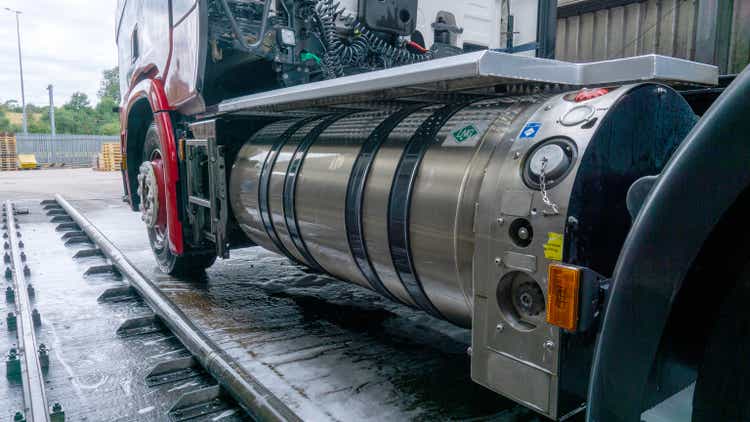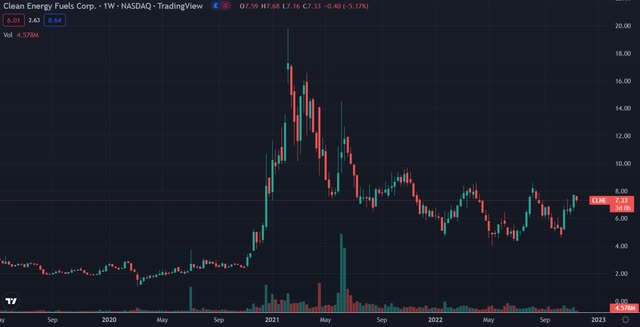steve631/iStock via Getty Images
Since February 8, 2021, when Clean Energy Fuels Corp. (NASDAQ:CLNE) almost reached a high of $20.00 per share, it has struggled to break out after finding a bottom of approximately $4.00 per share.
Since early January 2022, when it fell below $5.00 per share, Clean Energy Fuels has traded choppy, moving in a range of about $4.00 per share to around $8.00 per share up to this time.
I think part of the reason is the time it’ll take to build out infrastructure, the growing need to increase the diversification of its partners, incurring significant losses even with the alternative fuel tax credit, and the lack of capital needed for Clean Energy Fuels to scale at a faster pace.
In this article, we’ll look at its latest earnings report, the growing importance of Amazon (AMZN) in its growth plans, the diversification of its partnership base, and what the future holds for Clean Energy Fuels Corp.
Latest earnings
Clean Energy Fuels Corp. revenue in the third quarter was $125.69 million, up 45.99 percent from the $86.1 million in revenue generated in Q3 2021. Product revenue accounted for $113 million of the total, with service revenue representing the remaining $12.3 million.
Adjusted EBITDA in the quarter was $24.1 million, about $9 million above the $13.9 million in adjusted EBITDA in the same reporting period last year.
GAAP net loss in the quarter was $9 million, a little over $5 million above the $3.9 million net loss in the third quarter of 2021. For the first nine months GAAP loss is $46.4 million, with the company guiding for a GAAP net loss of $58 million for the year.
Operating expenses were $134 million in the reporting period, approximately $45 million above the $89.2 million in operating expenses last year in the same quarter.
Cash and cash equivalents at the end of the quarter were only $23.1 million. As for raising more capital, the company said it’s looking to secure a $150 million bridge loan that will take it into 2023. At the time of the earnings report, it hadn’t been closed on.
When asked about project financing, Clean Energy Fuels Corp. management said it’s going to wait until the projects are further developed, and at time are looking at another $200 million to $400 million in debt at the project level. When studying the infrastructure needs the company has in association with the RNG market, this is a relatively small amount of capital to work with.
The way forward appears to be an incremental and long one; a lot can happen on this type of business journey when competing in a unique fuel business that is still in the nascent stage of development.
Diversification of partnerships
One of the things Clean Energy Fuels Corp. needs to continue to do is expand its partnership base. It is working on doing that, but it has a long way to go before it mitigates a lot of risk related to a comparatively small number of partners that have market clout.
Among the more important ones that is growing is Amazon. I’m not going to get into that in this section; I’ll cover Amazon more thoroughly in the next section of the article. The key thing for now is to understand Amazon represents a lot of potential growth for CLNE, but if it grows to a large percentage of its partnership business, it could become a risk if Amazon decides to change its mind and go with someone else.
I don’t see that happening in the near future, but further out, as the sector and competition grow, transitioning to other partners could make sense to a company like Amazon. I mention that because management stated a key to its future growth is Amazon. What’s important is the company, over time, needs to be sure it’s not too big of a key, otherwise it faces enormous risk if Amazon pulls the rug out from under them.
Again, that isn’t a near-term risk, but is definitely could be in the years ahead.
Another significant partner Clean Energy Fuels recently signed a three-year agreement with is Waste Management (WM), for another three stations to refuel their trucks. Upon completion, that will bring the total number of refueling stations for Waste Management to 96 in the U.S. and Canada.
Another newly signed deal was with Valley Regional Transit in Idaho, for its fleet of 30 trucks. I also boosted its supply relationship with the Big Blue Transit agency of Santa Monica to provide it with 1.8 million gallons for 177 buses that run on RNG. An interesting deal was with Pasha, a company with container ships that will travel between Long Beach to Hawaii. CLNE already supplied 300,000 gallons to a 774-foot ship from its Boron, California plant. The company is adding two more container ships to its fleet, both of which are scheduled to be ready for launch in 2023. CLNE estimates that over the next five years they will require 105 million gallons of LNG from its plant in Boron.
My point in this section of the article isn’t to get into a deep dive of all its partners, but to show that diversification of partners is important, not only because it lends support to the validation of the market, but also protects the company if any significant partner or partners decide to go with another company.
The major challenge for CLNE isn’t demand or attracting partners, rather, it’s having the available capital to aggressively pursue more production capacity from potential fuel sources in order to meet growing demand. That will take a lot of capital, which opens the potential door for a company with deep pockets to compete against it.
One positive there is that the company does have a significant lead in infrastructure when measured against competitors or potential competitors, which means at the right time it could become an acquisition target of a large energy company looking to diversify its revenue sources.
Amazon
Since Clean Energy Fuels declared Amazon is a key to its future growth, it’s worth taking a deeper look at where things stand today, and where they may go in the future.
The first thing to note is, Amazon is expanding the size of its fleet of heavy trucks that are powered by renewable natural gas. Over the last year, Amazon has been fueling up its trucks at over 80 of the fueling stations it has across the U.S.
Per terms of the agreement with Amazon, Clean Energy Fuels Corp. opened up its first station “built from the ground up as part of our agreement with Amazon.” Located in the desirable location of Columbus, Ohio, it has the capacity to have 50 of Amazon’s Class 8 trucks to fuel contemporaneously.
The company is already making plans to expand the facility to allow 84 Amazon trucks to fuel up at the same time. Not only that, but the company, per its agreement with Amazon, will build 19 stations that are similar in nature to the Ohio station. By the end of 2022, stations should be open in Florida, Illinois, and Pennsylvania, with more to open in early 2023.
Management said in the earnings report that Amazon has plans to increase its fleet size to over 2,000 trucks, which plays well into CLNE’s plans to increase its fueling stations to serve the e-commerce giant’s renewable fleet of trucks.
Based upon the above information, this is why I say CLNE’s business with Amazon is safe in the near term.
Outside of Amazon, the company said it has plans to complete another 70 stations going forward.
This is why I believe its financing needs may be inadequate for the rising demand, taking into consideration the overall sector. It also points to the strong possibility supply could become an issue as its partnership base expands.
Conclusion
CLNE is one of those companies you want to like, based upon demand and favor it receives from the general population. But the company continues to lose a lot of money and will lose a lot more before its expansion slows down.
It’s obvious Clean Energy Fuels Corp. is attempting to secure market share before its competitors become a serious threat to the company. I’ve seen this before in many markets, though. Growth at any expense is dangerous when economic conditions turn against a company.
The major challenge for the company is increasing its supply in order to meet demand, controlling costs and debt in a difficult interest rate environment, raising capital, all while expanding its footprint to lock in key strategic geographic areas, such as Ohio.
Another thing is it seems there isn’t a logical process developed that can be provide the company with a road map to follow. It appears it’s grabbing up any business it can get to drive revenue and growth.
I do like the fact Clean Energy Fuels Corp. is diversifying its partnership base, although it is at risk from having its larger partners, at this time, representing a significant amount of its revenue growth. It’s taking steps to remedy that, but it needs to do more. Again, the problem is investment capital and measured growth.
Based upon the share price movement of the company, along with unrealized potential, I think Clean Energy Fuels Corp. has to prove the sustainability of its business model before its share price finds a bottom and is able to consistently move up in price over a longer period of time.
For now, even with some of its potential from larger partners, it looks like to me Clean Energy Fuels Corp. is going to have to have a lot more infrastructure and partners, while proving it can find the supply to meet the demand. Until that happens, I believe Clean Energy Fuels Corp. is going to continue to trade choppy without breaking out and finding support at a higher low.



Be the first to comment